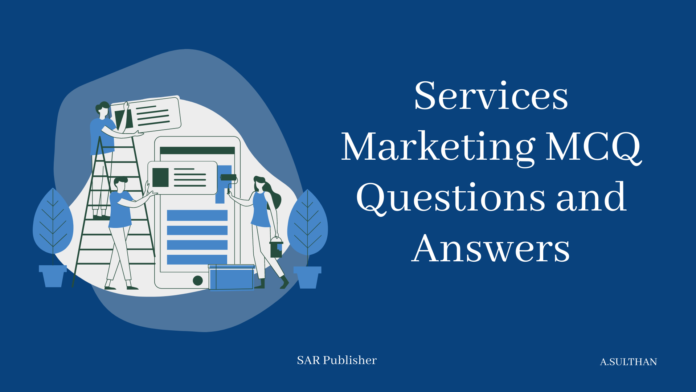Services Marketing MCQ Questions and Answers Part – 1
Services Marketing MCQ Questions and Answers Part – 2
Services Marketing MCQ Questions and Answers Part – 3
1. “Every business is a service business”- Who quoted this sentence?
A. Philip Kotler
B. Gary Hamel
C. Ravi Shankar
D. Ramaswamy & Namakumari
ANSWER: A
2. Which of the following products is an example of intangible dominant?
A. Insurance
B. Farming.
C. Mining.
D. Teaching
ANSWER: D
3. Which of the following statements about the pricing of services (compared to the pricing of goods) is false?
A. The demand for services tends to be more elastic than the demand for goods
B. Cost-oriented pricing is more difficult for services.
C. Comparing prices of competitors is more difficult for service consumers
D. Consumers are less able to stockpile services by taking advantage of discount prices
ANSWER: B
4. Charging customers different prices for essentially the same service is called
A. Price discrimination
B. Supply and demand.
C. Complementary
D. Substitutes.
ANSWER: A
5. Which of the following is not generally accepted as being part of the extended marketing mix for services?
A. Product
B. Price
C. Process
D. Practice
ANSWER: D
6. A buyer’s perception of value is considered a trade-off between
A. Product value and psychic cost.
B. Total customer value and total customer cost
C. Image value and energy cost
D. Service value and monetary cost.
ANSWER: D
7. Services are characterized by all of the following characteristics except for
A. Intangibility.
B. Homogeneity
C. Perishability.
D. Inseparability
ANSWER: B
8. Which of these statements can be considered as false.
A. Services cannot be touched or seen in the same manner as goods
B. Consumer judgments about services tend to be more subjective than objective
C. Customers involvement affects service quality
D. Services are first produced, then sold, then consumed.
ANSWER: D
9. Of the four unique service characteristics that distinguish goods from services, the one that is the primary source of the other three characteristics is:
A. Intangibility
B. Inseparability.
C. Perishability.
D. Heterogeneity.
ANSWER: A
10. Services that occur without interruption, confusion, or hassle to the customer is called
A. Seamless service
B. Service audit.
C. Functional service
D. Departmental service
ANSWER: A
11. The mental energy spent by customers to acquire service is referred to as _____.
A. Image costs
B. Monetary price.
C. Energy costs
D. Psychic costs.
ANSWER: C
12. The unique service characteristic that reflects the interconnection between the service firm and its customer is called
A. Intangibility
B. Inseparability
C. Homogeneity
D. Perishability.
ANSWER: B
13. Which of the following is NOT one of the service encounter themes?
A. Spontaneity
B. Adaptability
C. Responsiveness
D. Recovery
ANSWER: C
14. Which of the following statements pertain to inseparability is false?
A. As customer contact increases, the efficiency of the firm decreases.
B. Customers can affect the type of service desired
C. Customers can affect the length of the service transaction.
D. Customers can affect the cycle of demand
ANSWER: A
15. In addition to the traditional four Ps, the services marketing mix includes people, physical evidence, and:
A. Inseparability.
B. Planning
C. Production
D. Process
ANSWER: D
16. Distinct characteristic of services is_____________
A. Intangibility
B. Inseparability
C. Variability
D. Perishability
ANSWER: A
17. The unique service characteristic that deals specifically with the inability to inventory services is
A. Inseparability
B. Intangibility
C. Homogeneity
D. Perishability
ANSWER: D
18. Which of the following strategies increases the supply of service available to consumers?
A. The use of creative pricing strategies
B. The use of reservation systems
C. Capacity sharing
D. Developing complementary services
ANSWER: B
19. Customer satisfaction can be defined by comparing
A. Predicted service and perceived service
B. Predicted service and desired service
C. Desired service and perceived service
D. Adequate service and perceived service
ANSWER: C
20. The demand strategy in which service providers utilize their downtime by marketing to different segments with different demand patterns is associated with which of the following?
A. The use of creative pricing strategies
B. The use of reservation systems
C. Capacity sharing
D. Developing complementary services.
ANSWER: C
21. The __________ dimension is an assessment of the firm’s consistency and dependability in service performance
A. Empathy.
B. Responsiveness.
C. Assurance
D. Reliability.
ANSWER: D
22. Which of the following would not be considered a tangible clue?
A. The appearance of employees
B. The appearance of the firm’s physical facilities
C. The smile on an employee’s face
D. The quality of instruction in an educational setting.
ANSWER: D
23. Minimizing the amount of role conflict and role ambiguity experienced by employees will help reduce the size of this gap is known as ____________.
A. Knowledge gap.
B. Standards gap
C. Delivery gap.
D. Communications gap
ANSWER: C
24. Fixing a right price for services offered is difficult because of ____________.
A. perishability.
B. heterogeneity.
C. inseparability.
D. intangibility.
ANSWER: D
25. The world’s largest industry in the private sector and highest projected generator of jobs is______
A. The hospitality industry
B. Health services
C. Professional services.
D. Business services
ANSWER: D
26. Focusing the firms marketing efforts toward the existing customer base is called
A. Excellent customer service
B. Conquest retention
C. Customer retention
D. Courteous retention
ANSWER: C
27. Which of the following is an example of a common research objective in services?
A. to monitor changing customer expectations in an industry
B. to discover customer requirements or expectations for a service
C. to assess gaps between customer expectations and perceptions
D. all the above
ANSWER: D
28. The consumer decision process consists of
A. Stimulus, problem awareness, and purchase stages
B. Pre-purchase, consumption, and post-purchase stages
C. Problem awareness, evaluation of alternatives, and post-purchase behaviour
D. Stimulus, information search, and post-purchase behaviour
ANSWER: B
29. ____ involves identifying the benefits and attributes that customers expect in a service.
A. Future expectations research
B. Requirements research
C. Lost customer research
D. Process checkpoint evaluations
ANSWER: B
30. Service consumers tend to be more brand loyal than goods consumers because
A. More choices are available
B. Brand loyalty lowers the amount of perceived risk
C. Each service provider provides many brands
D. Location of the provider is the major driver in the consumer selection process
ANSWER: B
31. Competitor intelligence should be gathered
A. Once a year.
B. Twice a year.
C. Continuously
D. When competition is more.
ANSWER: C
32. Which of the following is not a benefit of customer satisfaction?
A. The firm is more insulated from price competition.
B. The firm provides a positive work environment for its employees
C. Positive word-of-mouth is generated from satisfied customers
D. Satisfied customers make purchases more frequently
ANSWER: B
33. The service industry has several emerging trends that organisations need to be aware of. Which of these
should organisations keep a lookout for?
A. New competitors entering the marketplace
B. Advances in the internet
C. Heightened customer expectations
D. Advances in e-commerce.
ANSWER: A
34. Andrea wants to be a dog groomer. She has enrolled in a training academy operated by Petsmart to learn
how dogs should be handled during grooming. The moment Andrea attended the indoctrination class at the
training academy was an example of an
A. service inquiry
B. service path crossing
C. service blueprint
D. service encounter
ANSWER: D
35. Customers ultimately determine the services by____________.
A. The type of competitors.
B. The levels of marketing effectiveness and operational efficiency
C. The cycle of fluctuations
D. The price of the competitors.
ANSWER: B
36. During a service recovery effort, the employee promptly refunded the customers money, but threw the money at the customer. As a result, the recovery effort violated the customers ___________ justice need
A. Interactional
B. Ethical.
C. Social.
D. Procedural
ANSWER: C
37. Soft technologies refer to
A. Flexible rules that can be bent to meet customer needs.
B. The personal touches that ultimately lead to customer satisfaction.
C. Guidelines that permit employee empowerment
D. Hardware that facilitates the production of a standardized
ANSWER: B
38. The __________ is calculated by dividing the activity time by the number of locations at which the
activity is performed.
A. Service cost per meal
B. Maximum output per hour
C. Process time.
D. Activity time.
ANSWER: C
39. Which of the following is not a step in the construction process of a service blueprint?
A. Obtaining scripts from both customers and employees
B. Segmenting customers based on the content of the script.
C. Identify steps in the process where the system can go awry.
D. Calculating the time frame for service execution.
ANSWER: C
40. A volume-oriented positioning strategy is achieved by
A. Reducing divergence.
B. Increasing complexity
C. Reducing complexity.
D. Increasing divergence
ANSWER: D
41. A buyers perception of value is considered a trade-off between
A. Product value and psychic cost
B. Total customer value and total customer cost.
C. Image value and energy cost
D. Service value and monetary cost.
ANSWER: D
42. Total customer value consists of all of the following components except
A. Product value.
B. Service value.
C. Image value
D. Personnel value.
ANSWER: D
43. H&R Block prepare income tax forms for its customers. Because many people avoid doing their taxes until the last minute, H&R Block offices are busiest during the six-week period prior to April 15th. The company instituted a sales promotion which awarded customers who had their taxes prepared early the opportunity to win double the amount of their tax refund. This strategy is to deal with the _____ nature of
services.
A. standardize
B. perishable
C. heterogeneous
D. tangible
ANSWER: B
44. Which of the following statements about the pricing of services (compared to the pricing of goods) is false?
A. The demand for services tends to be more elastic than the demand for goods
B. Cost-oriented pricing is more difficult for services
C. Comparing prices of competitors is more difficult for service consumers.
D. Self-service is a viable competitive alternative.
ANSWER: D
45. __________ is a firm’s view toward planning its operations according to market needs
A. Marketing orientation
B. Marketing functions.
C. Marketing department.
D. Marketing forecast.
ANSWER: A
46. Which of the following is not a criteria for effective price discrimination?
A. The segments should be identifiable, and a mechanism must exist to price them differently.
B. Different groups of consumers should have similar responses to price.
C. Segments should be large enough to be profitable
D. Incremental revenues should exceed incremental costs.
ANSWER: B
47. Service firms often find themselves in a three-cornered fight between
A. Engineering, production, and accounting
B. Marketing, finance, and human resources
C. Operations, accounting, and marketing.
D. Human resources, marketing and operations
ANSWER: D
48. Customer frustration resulting from receiving poor service is most similar to
A. Image costs.
B. Monetary price
C. Energy costs.
D. Psychic costs.
ANSWER: D
49. Among many services, the demand for medical services tends to be __________.
A. Inelastic.
B. Elastic.
C. Substitute demand
D. Price cross elastic demand
ANSWER: A
50. Which of the following is not an element of people?
A. Motivation
B. Teamwork
C. Flow of activities
D. Customer training
ANSWER: C


